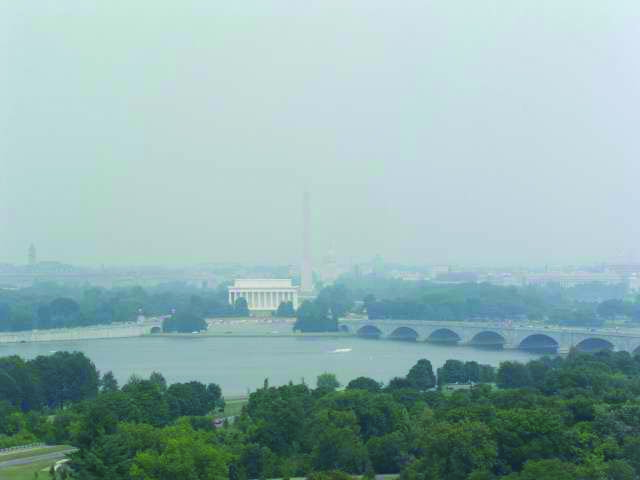In metropolitan Washington, the two most important pollutants that threaten human health are ground-level ozone and particle pollution. A typical adult breathes in close to 3,500 gallons of air in a single day. If the atmosphere is polluted with ozone and particle pollution, lung function may be reduced by as much as 20 percent. Visit Clean Air Partners for health tips and to learn about ways to protect the environment.
Ground-Level Ozone
Ground-level ozone is a colorless gas formed through a complex chemical reaction between volatile organic compounds (VOCs) and nitrogen oxides (NOx) in the presence of sunlight. Sources of manmade VOCs and NOx include:
- automobiles, trucks and buses;
- gasoline storage and transfer;
- large combustion and industry sources such as utilities;
- industrial use of solvents and degreasing agents;
- consumer products such as paints and cleaners; and
- off-road engines such as aircraft, locomotives, boats, construction equipment and lawn and garden equipment. VOC's are also produced naturally by certain types of vegetation.
High concentrations of ozone can cause shortness of breath, coughing, wheezing, fatigue, headaches, nausea, chest pain, and eye and throat irritation. The most common symptom that people have when exposed to ozone while exercising is pain when taking a deep breath. The EPA estimates that 5 to 20 percent of the total U.S. population is especially susceptible to the harmful effects of ozone pollution.
The following groups are most vulnerable:
- Children, because their respiratory systems are still developing. They're more active and spend more time outdoors, inhaling more air pollution per pound of body weight than do adults.
- People with pre-existing respiratory problems.
- Athletes and individuals who exercise outdoors.
- Older adults, because their respiratory and immune systems lose some of their resilience. Damage caused by ground level ozone pollution can aggravate existing conditions or irritate tissues that make them susceptible to infection.


A good air day versus a bad air day in Washington, DC.
Particle Pollution
Particle pollution or particulate matter is a pollutant that includes both solid particles and liquid droplets found in air. Particulate matter is the term for particles found in the air, including dust, dirt, soot, smoke, and liquid droplets. These particles come in a wide range of sizes. Particles less than 10 micrometers in diameter tend to pose the greatest health concern because they can be inhaled and accumulate in the respiratory system. Particles less than 2.5 micrometers in diameter are termed "fine" particles. Some particles are directly emitted into the air. They come from a variety of sources such as cars, trucks, buses, factories, construction sites, tilled fields, unpaved roads, stone crushing, and burning of wood. Other particles may be formed in the air from the chemical change of gases. They are indirectly formed when gases from burning fuels react with sunlight and water vapor. These can result from fuel combustion in motor vehicles, at power plants, and in other industrial processes.
Unhealthy levels of particle pollution in the air can cause or trigger significant health problems. These range from coughing and difficult or painful breathing to the possibility of an emergency room visit or even premature death. Exposure to particles can decrease lung function, weaken the heart, and possibly bring on a heart attack. The environment also suffers from particle pollution. Particles are the major source of haze, and can harm the environment by changing the nutrient and chemical balance in soil and water.
Additional Resources:
U.S. Environmental Protection Agency
AirNow
Ozone and Your Health
Particle Pollution and Your Health
Air Quality Index: A Guide to Your Health